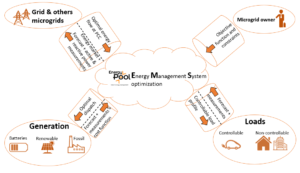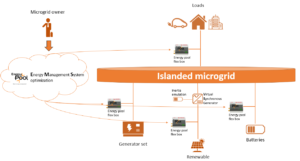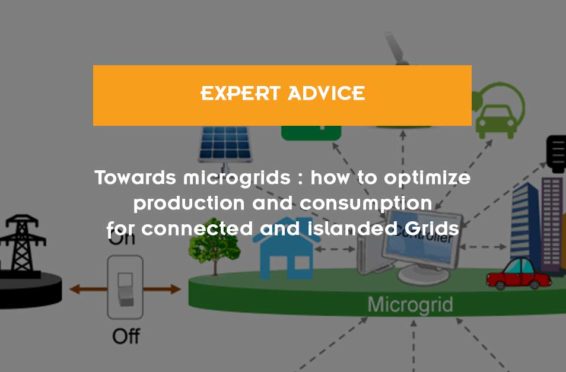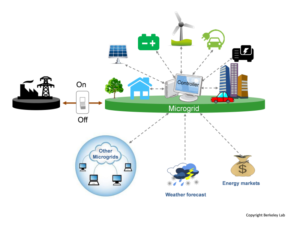Awareness of environmental issues has been growing for about half a century but has picked up momentum in the past decade. This combined with economic factors and the fast development of distributed renewable resources, enhanced an increasing interest in the future evolution of the energy sector worldwide.
In term of grid development, 2 questions are being raised:
-Should future power systems evolve in the form multi-autonomous small geographical areas, also called Microgrids, where load and generation are integrated locally ?
Or, on the opposite,
-Should we continue to develop large super-grids ?
Both models have benefits and limitations: on one hand, microgrids’ lack of long distance inter-connections have, as a result, an absence of inter-area oscillations and line congestion. microgrids are also a viable solution to secure electricity in case of local constraints such as Californian forest fires or political conflicts for example. However, such systems are prone to frequency and other issues if the balance between generation and demand is not met.
On the other hand, Super-grids such as the European “copper plate” bring a benefit for end-consumers derived from a more efficient use of the power system and cross-border infrastructures, but sometimes these systems fail to address local issues.
From a technical point of view, microgrids are a huge opportunity to rethink the way of producing as well as consuming, giving the priority to local and green energies. A microgrid can be used in several modes : either connected to a larger power system, voluntarily isolated to supply off-grid areas or islands, or even involuntarily isolated because of a power blackout or disturbances on the main grid.
This article gives a general overview of all microgrid possibilities. At first , our expert Jean Dobrowolski draws up the state of the art of microgrid researches and projects around the world. In the second part of the article, he focuses on connected microgrids, highlighting the objectives of energy optimization in this kind of systems. Finally, he presents the upcoming challenges of islanded microgrids where Distributed Energy Resources (DER) must not only generate energy but also participate to grid stability missions.
If you are a Utility and you already want some info on microgrids, contact directly one of our experts here :
Ask our microgrids’ experts here !
1. State of the art of microgrid story
Microgrids are localized and autonomous electrical distribution networks composed of Distributed Energy Resources (DER) including storage assets and loads. Today’s projects range in size from few kWs to hundreds of MWs. Within a fast evolving energy landscape, microgrids are the right solution to bring local and decentralized production in a large and centralized grid. Indeed, they act like grid service suppliers as long as the main grid is connected, giving the priority to local (and green) producers. They also ensure continuity of service when it is deemed necessary.
Fig. 1. Microgrid synoptic view
Figure 1 shows a typical synoptic representation of a microgrid including Energy Storage Systems (ESS), industrial and residential loads, local producers, some prosumers (typically Electrical Vehicles), some fossil energy based producers, one Point of Common Coupling (PCC) with the grid, and the so-called Microgrid controller. Depending on the objectives of the controller, it is also advised to take advantage of real time data from the energy market (for cost optimization), weather forecast (to improve renewable penetration) and other microgrids modes (to optimize services to the grid).
Microgrid projects differ mainly by their size or by their initial objectives. For a Utility, different reasons can justify to invest in a microgrid:
-Electrification of an off-grid area
-Give the priority to local green production for environmental reasons
-Political reasons such as ensuring the continuity of service in areas subject to terrorism attacks on the main network.
As long as the microgrid is synchronized and connected to the main grid, the microgrid controller will act as an Energy Management System which aim to optimize the behavior of the grid based on predefined goals.
2. The Energy Management System for an optimal connected Microgrid
If connected to the main grid, the microgrid does not have to care about the frequency and voltage regulation. Thus, the microgrid controller will have to deal with energy issues and optimization, hence the name Energy Management System (EMS). The main EMS control topics are:
– Reduction of line congestion
In a given microgrid perimeter, the multiplicity of consumers coupled to a growing consumption can lead to a situation where distribution lines become undersized over certain periods. The EMS can play a key role in the reduction of line congestions. For example, thanks to accurate weather forecast, it is possible to shift the electrical car charging after a peak of consumption, or when renewable production is high.
– Local management of renewable sources and battery storage:
Battery management is quite challenging. If it is charged when not necessary, some renewable production can be lost, if it is discharged during the wrong period, the benefits could be reduced. This enhanced a lot of research on optimal algorithms to deal with batteries and renewable sources that proved the advantage of proximity between batteries and renewable sources for an optimal behavior of a local system.
– Local management of the energy flow from producer to consumers:
The EMS’s purpose on a connected microgrid can also be described as a sophisticated solution to control the energy flow between producers and consumers. It means that with parameters like the energy markets behaviour, the load measurement and forecast, the producer’s production, forecast and cost function, and the grid state and forecast, it is easy to design the right optimization pattern which minimize an objective function with a production and consumption profile for the controllable loads and production assets. Usually, the sampling time for an EMS is between 15 and 60 minutes.
Figure 2 resumes this idea in a block scheme.

Fig. 2. Energy Management System interactions in a microgrid
Among more than 400 microgrid projects listed in the world, some are fitting with the above description.
Here are some examples:
-The Tesla microgrid in American Samoa which aims to optimize the behavior of a 1,4 MW solar farm with 6 MWh of batteries.
-Californian microgrids aim to discharge the very congested transmission lines with some projects as large as 10 megawatts.
-The Milford microgrid aims to encourage some facilities to operate independently from the grid when it is possible to reduce the load on the main grid. In this project, 5 facilities have the ability to operate in islanding mode, with 120 kW of solar panels, 292 kW of gas and diesel generator, and 30 kW of storage.
Once a microgrid operates in islanding mode, the roles of the subsystems are very different from a connected microgrid since the main grid is not ensuring the frequency and voltage regulation anymore.
3. The Power Management System for an islanded microgrid
In islanded microgrids, the stability of the frequency and the voltage control have to be managed by the distributed producers. Indeed, in contrast to the connected mode, distributed resources will not anymore operate in the so-called grid-tie mode (=catching the frequency and amplitude of the sinusoidal wave imposed by the main grid) but in grid-forming mode, meaning that they need to create the voltage wave.
In addition, there could be a lack of inertia which is very important in grid stability. Usually, generators set are dedicated to this task, since they have inertia. But of course, the utilization of generator set 100% of time in order to get inertia is a non-sense with all the environmental issues that this implies.
Thus, research on islanded microgrid can be split in two parts : hardware and algorithm
3.1) The hardware solution
This first part is out of the scope of this article but must be shortly described for the understanding of the last part of this article. To add the grid-forming functionality to renewable production, one solution is to copy the behavior of a generator set in an inverter. Thus, it will have the ability to create the voltage wave and, by associating a small batterie in parallel to emulate inertia, it creates the so-called Virtual Synchronous Generator (VSG). This VSG is the key of a 100% renewable grid since it solves the problem.
Let’s consider that this technology is available for the rest of this section.
3.2) The right algorithm
The second part of the research is related to process of finding the right algorithm to ensure the stability of the microgrid and to keep the objective function optimized. Technically, the EMS presented in Section 2 is still useful and usable, but a second control layer is mandatory to ensure stability: the Power Management System (PMS). The main difference is that the EMS is a central controller that predicts optimal productions and consumptions profile for the next 15 minutes (in average) when the PMS is a decentralized controller, directly connected to the sub-systems and that deals with real time constraints (inaccuracy of the EMS’s forecast, unpredicted trip of a generator, etc.).
A PMS has three operating modes:
– Normal mode: In this mode the PMS follows the optimal profile of the EMS and deals with the small unexpected variations
– Degraded mode: In this mode the PMS can take some decisions when the EMS profile is not feasible
– Secure mode: In case of communication failure with the EMS, every PMS has its own simple optimization model that does not need any communication between producers. This mode was part of the special research of my PhD, available here. (French version).
3.3) Use case
Let’s consider a simple use-case to explain all the modes.
Figure 3 represents a simple islanded microgrid composed of a generator set, renewable sources (equipped with the VSM solution), controllable loads, and not controllable loads. The central EMS is available, and it communicates with all the PMS directly implemented in Energy-Pool flex-box.

Fig. 3. Use case of islanded microgrid
In the normal mode, the microgrid owner gives its requirements in terms of objective function and constraints and the EMS is calculating the optimal energy profile for the next time slot, based on production and consumption forecasts. This profile is communicated to all the flex-boxes which follow it as long as it is possible, including the power variation component due to load and production dynamic.
Let’s now imagine that the energy profile send by the EMS includes only renewable production. Generator set are stopped, and batteries are 50% charged. This situation is the most critical, since renewable power is highly volatile. Since the calculated renewable profile is based on weather forecasts, there is a non-negligible risk of blackout in case of significant forecast error. The degraded mode is activated to correct the profile of the EMS and to activate batteries and/or generator set when needed, thus avoiding blackouts.
Another critical situation can happen when there is a communication problem between the EMS and the flex-boxes. In this case flex-boxes do not have any information from the EMS about load measurement and renewable production forecast. This state is called secure mode. That can also be a normal mode in some remote area, where communication is unstable, difficult to establish, or nonexistent. In this situation, all the flex-boxes will use an integrated algorithm which is built to regulate the frequency. Thus, since islanded microgrids have more flexible grid codes, it is possible to act on the grid frequency to communicate with other producers/loads.
The islanded microgrid projects, without any connection to a main grid are mainly located in Africa and in islands. We can for example cite the Hybrid Solutions Deliver Energy and Cost Savings for Mauritania with 1300 kW of solar and 5000 kW of Diesel and Gas energy, or the La Palme Canary islands microgrid which aim to encourage renewable penetration instead of generator set based on diesel.
4. Conclusion : the World is progressively adopting microgrids, what about you ?
The world is facing a major energetic crossroads, the current health crisis proved again how much environmental efforts are necessary in a very short term. In this context, microgrids appear as a viable solution to overcome several barriers to renewable energy. Many projects are ongoing everywhere in the world, either to bring green electricity in not connected areas, or to secure it in more developed areas.
If you represent a Utility or an actor of the electricity sector, and if mivrogrids interests you, contact us to for more details about our solutions and services.
Need to get a study on microgrid for your utility ? Ask our experts here !
Jean Dobrowolski is a project manager at Energy pool : he currently assists Utilities in Europe, Africa and Asia, on microgrids projects and advise them on their value creation strategy.


